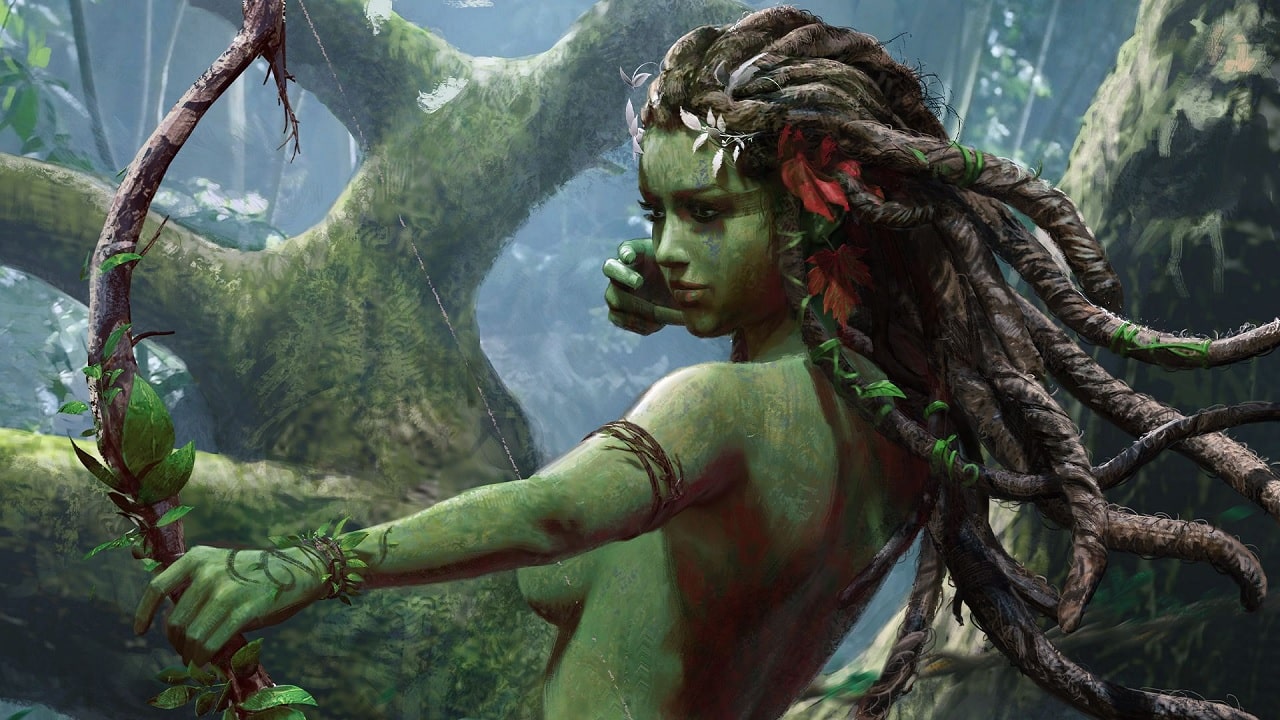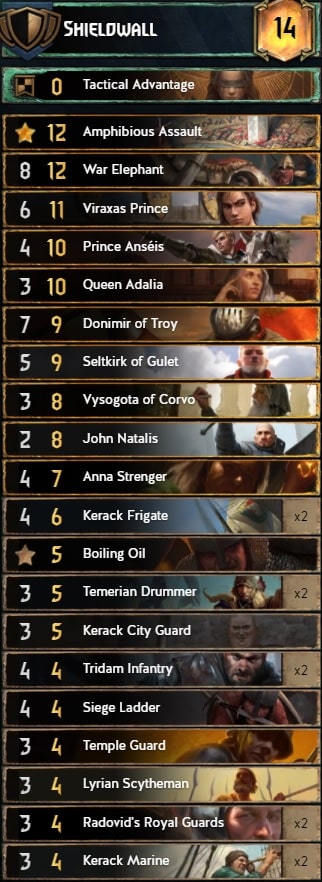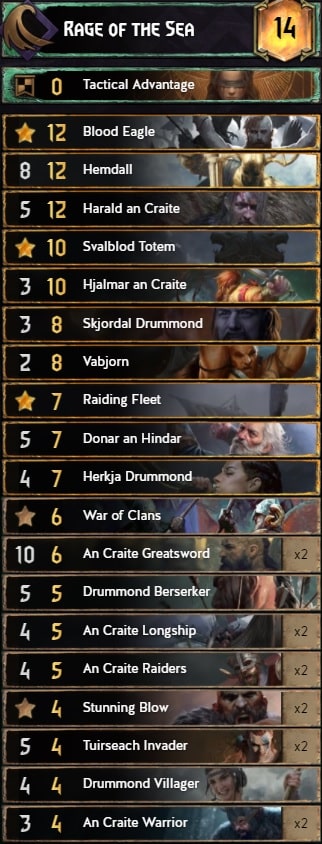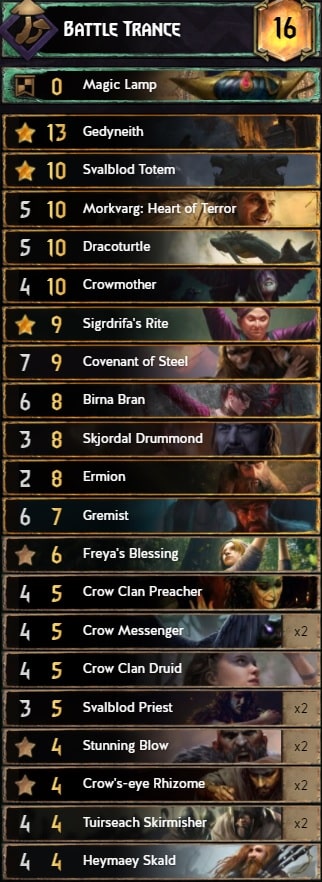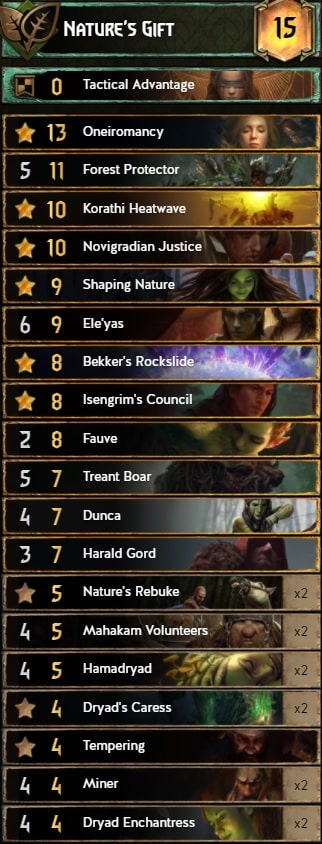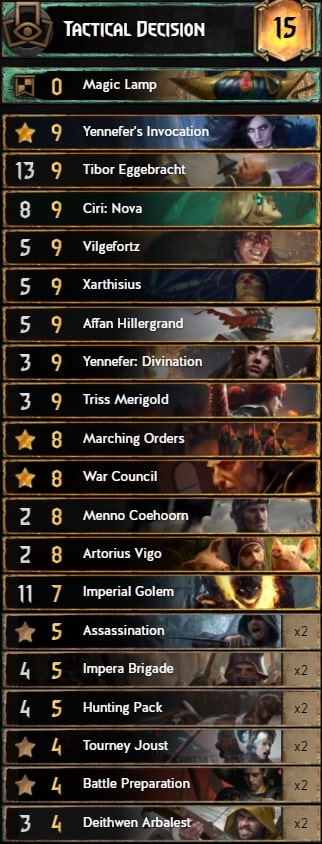Welcome to TLG’s patch review for Season of the Dryad! The main focus of this update are the new and changed leaders, but there have been some quite important balance changes as well. Within each faction accordion, you’ll find a detailed breakdown of the new abilities and other notable card tweaks.
While it’s still early into the meta, we included some decks (and gameplay videos) for the more promising leader abilities. You can join our Discord if you have any questions.
Writing: Sebodunum
Editing: Wusubi, Minuano
Consultants: Anda, Gravesh, Green-Knight, Lorakko, Nimraphel, Pajabol, Stellabrate, SpyroZA
- All evolving cards except Viraxas have gone up from 11 to 12 provisions. Auberon was nerfed to 5 base power.
- Ethereal no longer transforms automatically at the end of your turn, now gets an Order ability after the first transform. This makes it vulnerable to removal, effectively forcing the card to disappear from the meta.
- Oneiromancy has gone up from 12 to 13 provisions. This makes non-Devotion decks worse.
- Thinning bronzes (e.g. Mahakam Volunteers) significantly buffed for all factions.

Mobilization and Pincer Maneuver have been modified to fit the developer’s new leader ability ethos, whilst Shieldwall storms into the fray to make up for Vicious Slash’s exit. Shieldwall is a leader ability that takes what is already good and what is already bad about NR and amplifies it. It opens up greedier strategies of being able to use the most powerful engines and Duel cards, while reducing their chances of being removed or mitigated.
NR appears to be the faction benefiting the most from this patch. This is mainly because NR’s engines are balanced around the fact that they can be easily removed (e.g. Vysogota of Corvo at 3 base power). Shieldwall offers them protection and effectively eliminates that downside to a sizable extent. Unsurprisingly, playing good engines that are very difficult to remove is a reliable way to win a game of Gwent.
- Siege Mobilization is dead, making Siege even less popular.
- Prince Anséis hasn’t changed per se, but his potential has skyrocketed with Shieldwall allowing for gigantic Duels.
- NR’s greediest engines such as Vysogota of Corvo and Anna Strenger benefit greatly from Shieldwall’s protection.
- Shield synergy cards like King Roegner and Windhalm of Attre have more chance of seeing play now, but the usual Uprising suspects are inevitably going to be stronger with Shieldwall than a more Shield-based deck.
- Cintrian Royal Guards are huge beneficiaries of the Mobilization change. Even though the leader doesn’t proc their Deploy, having an extra copy along with potential Queen Adalia and Reinforcements can play for serious points.
Core cards: Anna Strenger, Prince Anséis, Seltkirk of Gulet, Viraxas, Vysogota of Corvo, Donimir of Troy
Shieldwall is effectively the old Carapace ability, but now paired with a more synergistic faction. You’ve got two points of boost plus a Shield, spread out over three charges. Shield on demand will obviously be powerful with Duel cards like Prince Anséis and Seltkirk of Gulet, as well as engines that require protection such as Vysogota of Corvo, Anna Strenger and Kerack Frigate.
Vincent Van Moorlehem will obviously feast on your shielded targets, but that’s the only unfavorable interaction at this stage. With Vicious Slash gone, Shieldwall - despite being a defensive ability - can offer some incredible control options, especially if you go all-in with the aforementioned Duel cards plus Viraxas. As such, it’s a highly flexible leader ability, with the potential for facilitating both protection and efficient control tools.
Shieldwall is by far the best ability of this patch, and may require a hotfix in the near future. An example of this strength is that using a single charge on Prince Anséis enables the eye-watering ability to Duel a 15-power unit without any additional set-up, meaning you can pretty much answer every threat in Gwent (especially when Viraxas and Seltkirk can be added into this mix for up to three devastating duels per game).
With the Duel power plus the effective safeguarding of deliberately delicate engines like Vysogota of Corvo and Anna Strenger, it’s expected that the devastating potential of this leader will lead to players aggressively teching against it with cards such as Korathi Heatwave, locks, Vincent Van Moorlehem or even Tesham Mutna Sword, as well as queuing NG Masquerade Ball decks for the explicit purpose of taking on the mighty Shieldwall.
Yet, while Poison has always been strong against NR, Shieldwall often allows for immediate value to be gained from its shielded targets (e.g. Prince Anséis, Seltkirk with Zeal from Ildiko or the recently-buffed Siege Support), meaning that even the supposed counters to Shieldwall will still suffer.
In addition, Shieldwall offers a better way to utilize the engine-overload package with Vysogota, Dandelion, Priscilla and Shani, since it’s nearly impossible to deal with both Donimir of Troy and a Vysogota with 5 power and Shield. However, if you’re aiming to build the best Shieldwall deck you can, it will end up looking very similar to the last season’s Uprising deck.
Core cards: Two copies of Cintrian Royal Guards should almost always be played with the reworked Mobilization. Queen Adalia, Amphibious Assault, Reinforcements and John Natalis will be a great package for this leader ability.
Mobilization now spawns a base copy of a bronze soldier, rather than taking a copy of a bronze card from your deck. Thus, there is no more potential for Siege shenanigans. At first glance, this might make this leader seem weak. However, there is a fantastic synergy when it is used with Cintrian Royal Guards. Although using the leader ability doesn’t proc their Deploy ability (because of the Spawn keyword), having an extra copy on the board makes their snowball potential much higher.
On top of this, by Spawning a copy rather than taking one from your deck, you are now more free in your mulligans. It can also be used with Draug-based Kaedweni Revenant decks, but that doesn’t seem to be as strong as the Cintrian Royal Guard option. As such, Mobilization is now both a combo leader with the Cintrian Royal Guards and an engine-overload leader.
Instead of drawing and playing a card, you draw a card and boost it by 5 if it’s a unit, then shuffle a card from your hand back into your deck. Pincer Maneuver remains a consistency option for a notoriously inconsistent faction, and is thus useful when you miss key cards, but much less so when you do actually draw your golds. The boost by 5 allows for missed top-end golds to not only be played when they otherwise wouldn’t have, but also to have a greater impact.
For example, there is the potential for a huge Duel with Prince Anséis, or to protect vulnerable engines like Anna Strenger and Vysogota of Corvo. It does technically also allow you to draw something like Amphibious Assault, although you would miss out on the crucial boost by 5 if you did so.
However, in comparison with Shieldwall, Pincer Maneuver offers a lot less value, since it only increases the potential of one unit rather than Shieldwall’s three. Pincer Maneuver previously allowed you to Deploy two threats in one turn, but is now unlikely to see much play when it has to compete with clearly stronger leader abilities.
At this stage, we think it’s slightly underpowered. Maybe it’s simply in Shieldwall’s shadow for now. We know that Uprising is a great leader ability, but it doesn’t see any play with Shieldwall in the game.

Second Wind has been exhausted, Sacrificial Vanguard has been slaughtered. Warriors remain strong, Rage of the Sea is a great and flexible alternative to Patricidal Fury. SK gains its own version of Mahakam Forge in Battle Trance, with a better special card, but a less consistent passive ability. Birna Bran and Tuirseach Skirmishers were buffed by 1 power to placate players after the loss of Sacrificial Vanguard. It fits quite well with the new Battle Trance leader (see below).
At first glance, the changes to An Craite Greatsword might seem like a nerf, but in fact it’s quite the opposite. They are no longer row-locked, they have a 1-point higher floor and they’re useful backup targets for self-wounding or for tanking weather damage.
Although Greatswords are now capped at 10 points, they no longer play into resets and are thus a reliable 10-for-6 in most games. Finally, they work very well with Rage of the Sea and provide excellent (and relatively cheap) targets for Hjalmar.
Self-wounding decks with Svalblod Priests and Dracoturtle or Armored Drakkar are helped by the emergence of Battle Trance, whilst the buffed Discard package and the Gedyneith Scenario fit very well into the mix. Of course this archetype is inferior to Bloodthirst Warriors, which is still the go-to deck for SK players.
Core cards: Other than the Warrior package with some Raid cards, 2x An Craite Greatsword is a neat inclusion for extra value, along with Hjalmar an Craite for powerful removal in subsequent rounds.
Rage of the Sea appears rather unassuming amongst the new leader abilities, but it’s more powerful than the first impression might suggest. At its core, it’s a good base value alternative to Patricidal Fury, with the nice versatility of a charge-based leader. Being able to invest part of the leader’s power through charges is very useful in moments like defending the bleed.
It also synergizes with An Craite Greatsword (a single leader charge can heal it outside of removal range) and Bloodthirst cards such as Madman Lugos and Wild Boar, while gaining value through Beast synergy (which the developers mentioned will be the focus for SK in the next expansion). Even without these synergies, though, it offers solid value.
Assuming there are suitable targets for Rain (and it’s not impeded by shields and armor), this ability can play for net 12 points, which is a better evaluation than Patricidal Fury’s 8 points, as well as avoiding playing into tall punish like Arnjolf the Patricide. In terms of pure value, then, it offers a very good alternative, with more flexibility.
However, one downside is that Rain doesn’t enable your Bloodthirst right away like Arnjolf the Patricide with Deafening Sirens. This means that you can’t immediately answer a threat like Donimir of Troy with Champion’s Charge. Overall, Rage of the Sea appears to be a strong leader ability for SK.
Core cards: Svalblod Priest with Dracoturtle or Armored Drakkar, Covenant of Steel, Ermion with Sigrdrifa and Freya’s Blessing, Gedyneith with more Druids and Alchemy cards like Crowmother, Crow Clan Preacher and Rhizome
Battle Trance is essentially the SK version of Mahakam Forge, albeit with a less consistent (but not much weaker) passive ability. This leader is best served by fitting three useful packages into your deck: Gedyneith with Druids, some Discard and Self-wound. Druids and self-wound now interlink thanks to Svalblod Priest’s prior buff and acquisition of the Druid tag.
Freya’s Blessing and Sigrdrifa’s Rite allow you to replay Svalblod Priests and their targets in Armored Drakkar, Dracoturtle and Covenant of Steel. The buffed Discard package of Birna Bran, Tuirseach Skirmishers and 1-2 copies of Heymaey Skald will play for a lot of tempo, while ensuring that you’ll find the key pieces like Gedyneith.
Mardroeme can play for 12 points when used on Dracoturtle, which however plays into tall punish. The healing passive while playing Alchemy cards can be of little value, as your main targets for self-wound will be those with armor and opponents may deliberately avoid damaging your other units to prevent you from getting extra value. Finally, many Alchemy cards appear to have been power-crept after the Master Mirror expansion, which obviously doesn’t help.
Yet, if you build the right deck around Battle Trance, it can be better than most people currently think. Spawning Mardroeme will boost a suitable target and Crow Clan Preachers, while granting an easy way to summon Crowmother from the graveyard.
When all this is taken into consideration, the leader ability can be worth even more than 12 points when using it on Dracoturtle. For example, Green-Knight had a 17-point leader on a board consisting of a protected Dracoturtle, bonded Crow Clan Preachers, a summoned Crowmother and some healing.

Harmony going back to the good old days brings all the Harmony cards back into consideration, albeit with Call of Harmony as leader instead of Mystic Echo. Brokilon Sentinels go down to 4 provisions - this gives you very little reason not to play them with Precision Strike, and makes the leader itself even stronger.
- Harmony’s devastating nerf has been reverted, but Mystic Echo no longer exists.
- Nature’s Gift added, Call of Harmony changed.
- Precision Strike is probably still the best leader for ST because Schirrú remains very strong.
- The combination of Nature cards, some Symbiosis engines and Nature’s Gift makes for a powerful Harald Gord deck.
Hamadryad is a key target for the Vitality of Nature’s Gift, whilst other Symbiosis engines help take further advantage of a leader with a Symbiosis passive. Cards such as Pavko and Figgis Merluzzo will benefit from the protection provided by Vitality. The buff to Mahakam Volunteers means that Novigradian Justice can now play for 13 tempo with 2 thinning, which is ridiculous.
Core cards: Nature cards and Symbiosis engines are the obvious beneficiaries here. Nature’s Rebuke will get even more value with the higher prevalence of Treants on the board. Hamadryad synergizes with the Vitality charges.
Other engines (Pavko, Treant Boar) and even Figgis Merluzzo can be boosted out of removal range with a single leader charge. Including lots of Nature cards means that Harald Gord will play for an astounding amount of points. It’s also worth noting that with this leader, the math on Shaping Nature finally checks out.
A relatively strong passive in terms of Symbiosis is combined here with a small but useful Vitality-giving ability. This means that Wandering Treant will be spawned with every Nature card you play, whilst engines and other important cards can be protected with the Vitality charges. Compared to Precision Strike, the leader of choice for Symbiosis decks prior to this patch, Nature’s Gift has a greater pure point potential.
As a pointslam deck, it has a much better Round 1 and can more easily push in Round 2. Yet, Precision Strike with Schirrú likely remains the overall more powerful option for ST, as its removal continues to be of paramount value.
Core cards: All the old Harmony favorites like Fauve with Water of Brokilon and Call of the Forest, Barnabas, Figgis Merluzzo, Pavko, Treant Boar, Percival, a pair of Half-Elf Hunters and a healthy balance of units that can proc Harmony.
Mystic Echo is dead, long live Call of Harmony! Dana Méadbh acting as a 6-point body with a unique Relict tag is as good as it’ll get without double Water of Brokilon. Call of Harmony is effectively a weaker version of Mystic Echo, with three more provisions. Since Harmony has reverted to its old form and Dana Méadbh makes other Harmony engines harder to kill when she is played, there should be a niche for this leader, although it’s perhaps unlikely to be found in the upper echelons of the ladder.
Although one’s initial instinct may be to compare Call of Harmony with Mystic Echo, it’s better to compare it with Nature’s Gift. Both are pointslam leaders, but Call of Harmony seems weaker than Nature’s Gift. This is much less due to the leader itself and much more a result of the long time that the Harmony cards have been around for and the amount of nerfs they have received.
Currently, Harmony appears to have been power-crept when compared to the newer cards in the game, especially with regard to their bronze cards in comparison with the new Nature and Symbiosis cards. It shouldn’t be assumed that Harmony will come straight back to its formerly-held top tier status.

Strategic Withdrawal is no more, Imprisonment arrives (and disappoints everyone). Tactical Decision is more interesting and Imperial Formation loses one leader charge, but gains one provision. NG may still find value with their Masquerade Ball decks when aiming to hard-target NR’s strong Shieldwall, but the faction seems to have come out of this patch weaker than before.
- The nerfs to Vincent Van Moorlehem and Braathens don’t bode well for the faction’s competitiveness - Vincent goes down by 2 power and 1 provision, Braathens by 1 power.
- Hyperthin is probably the best bet for the reworked Tactical Decision, however it might end up being used as a consistency leader with Affan for a solid 11-point play in Masquerade Ball decks
- Battle Preparation’s boost goes up by 1, whilst Ffion var Gaernel’s power goes down by 1 (Morkvarg: Heart of Terror can now remove him completely).
Tactical Decision, unlike Imperial Formation, was sufficiently changed to make it worth including in this article. Now, instead of playing a card from the top 3 cards of your deck, you get a 6-point body in Morvran Voorhis and the ability to draw up to 3 cards, then put the same number of cards on top of your deck.
Morvran Voorhis is merely a Soldier and not an Aristocrat, so he won’t proc Masquerade Ball. Perhaps as a consolation, his status as a created card means he procs Assimilate engines such as Braathens and Van Moorlehem’s Cupbearer, whilst his Soldier tag means he procs Ard Feainn Crossbowman.
In essence, NG likes to tinker with decks, be it their own or their opponent’s. Knowing which cards are on top of your deck can lead to some great combos with Joachim de Wett or Vilgefortz and Tibor Eggebracht. In addition, there is always the option to potentially un-brick cards like Roderick of Dun Tynne, or even your entire gameplan if you’re playing a Hyperthin deck and you need to put your essential Reveal target(s) back into your deck.
Using Tactical Decision in combination with Joachim de Wett allows you to set-up an important, yet possibly weakly-powered (e.g. Vattier de Rideaux or Stefan Skellen) card on top of your deck, so that Joachim can put it at a power that can comfortably sit outside most forms of removal.
A clear downside to Tactical Decision’s new form is that it becomes weaker the better your hand quality is. Moreover, if you fail to have Affan in hand by the time you use your leader, he acts as a very weak card for his provisions. The way to play around this is with a deck that thins a lot but also pulls off some strong combos, which is exactly what Hyperthin does.
In its current state, Tactical Decision is most likely to see play in Hyperthin decks, which thin a lot by including the newly-buffed Impera Brigade and Hunting Pack. Most of the leader value is centred on drawing Affan, otherwise it’s merely a 6-point leader that improves hand quality, which isn’t very strong. There’s also the potential for greedier decks that utilize Joachim de Wett to protect their most valuable cards. Masquerade Ball can of course also be played with this leader ability.
Imprisonment is a very basic leader that essentially amounts to a couple of Collars on demand. The damage dealt by the ability can in fact be anti-synergistic sometimes, as it diminishes the value on cards like Vanhemar or Vattier de Rideaux. What’s more, NG already has an abundance of control tools, so this leader doesn’t serve it particularly well. In this way, Imposter does a similar thing but better, so Imprisonment is likely restricted to newer players.
Having said that, there’s a possibility that Imprisonment could see some play in an engine-heavy meta, especially if Shieldwall continues to take over the game. When compared to the likes of Imperial Formation and Tactical Decision, though, it’s 5 points worse off from the lack of Affan and it has less flexibility when bleeding or defending the bleed.
Thus, the utility of two locks is probably not worth it (depending on the meta). This leader shouldn’t be written off entirely, but we aren’t expecting it to see much play, as it isn’t strong enough and doesn’t really enable many synergies.

MO seem to be damaged by this patch, with relatively weak new leaders and formerly-powerful decks now no longer viable or simply impossible. Carapace and Force of Nature were finally changed, but neither are any impressive. White Frost comes in as the substitute for Death’s Shadow; it has interesting possibilities but is unlikely to be strong enough to see much play.
- The big nerf to Ethereal means Fruits of Ysgith is unlikely to see play anymore.
- Kikimore Queen decks are heavily damaged by the removal of Death’s Shadow.
- For some reason, Auberon was harshly double-nerfed, going up 1 provision and down 1 power.
It looks like the faction will have to rely on Overwhelming Hunger Devotion shenanigans with Haunt and a small Frost package with Ard Gaeth, Winter Queen and Ge'els. The one thing MO have going for them this patch are the cheap and powerful bronze thinning cards - both Foglets and Wild Hunt Riders have been buffed to 4 power.
White Frost naturally makes several Wild Hunt units better with access to extra Frost, as well as movement on demand, which can deal with row-locked cards. These can be reinforced with engines like The Apiarian Phantom or The Beast, which pressure your opponent to play higher tempo or pass. White Frost is difficult to judge fairly, because outside of Overwhelming Hunger, MO as a faction is in a bad place at the moment.
One thing that can be said is that it’s debatable whether there’s sufficient pay-off for the Frost archetype. Naglfar’s Crew is easy to remove and Wild Hunt Bruisers will lose some of their value with the leader acting as movement. White Frost possibly being one of the better leaders for MO goes some way to telling you the state of the faction after this patch.
Unsurprisingly, Wild Hunt and other Dominance cards will be best-served by this leader. Wild Hunt Bruisers will enjoy swinging their skull-infused hammers, while Naglfar’s Crew and Auberon himself will also be the obvious inclusions. Winter Queen could be paired with Red Riders and leader for more flexibility than Ard Gaeth.
A pretty vanilla leader, it will serve newer players a lot better than those at the higher ranks. Woodland Spirit plays as a 9-point body that procs Thrive and helps achieve Dominance. There’s certainly something to be said for the reach and ability to provide pressure that this leader combined with another card can offer, especially when used in conjunction with Imlerith’s Wrath, but other leaders usually have a higher ceiling and more flexibility.
The issue with this leader is that in the round when you most often want to be using your leader ability, Round 3, you want to play your best golds instead of setting-up a long bronze Thrive curve. As a result, Force of Nature is a decent pointslam leader, but neither very strong nor very interesting when compared with the majority of other leaders in Gwent.
Endrega Larva is the clear beneficiary here with a potential double-proc with leader, as well as Dominance-based cards like Adda: Striga. To put it bluntly, however, Force of Nature won’t inspire much fear in a seasoned opponent.

Wild Card is no longer in the game, replaced by Pirate’s Cove. Hidden Cache seems almost certain to remain the clear leader of choice for SY. Sacred Flame receives a huge buff; its points ceiling in a long round is far higher when boosting all Firesworn units. It can be said with some confidence that Congregate Firesworn swarm will have more of a chance to be competitive now.
Ewald is now more strongly linked to Horst, coming in at 5 power for 7 provisions and damaging by 2 or 4 depending on whether his brother is in the graveyard. Instead, Whoreson’s Freak Show is the new damage-by-2 spender, with the addition of 1 armor.
This leader is SY’s first that provides a way of spending coins instead of only generating them. It would be well-served by a deck that focuses on coin generation. In terms of practical utility, having a spender on demand (plus 4 coins) could be game-saving. Having said that, it may be unwieldy to use, as it incentivises mulliganing away spenders while stopping you from collecting more than 5 coins so as not to waste the +4 coin bonus.
Pirate’s Cove doesn’t offer as much value as Hidden Cache does. As a result, it’s unlikely for it to see much play at the moment. This is because although it allows you to use your spenders more freely, you often want to save Jacques de Aldersberg as your Round 3 spender anyway. Moreover, like all SY abilities outside of Hidden Cache, your Hoard engines are weaker, it’s harder to get The Flying Redanian out of your deck and it’s difficult to gain round control and bleed the opponent in Round 2.
While Pirate’s Cove is definitely playable, it’s not very strong. Indeed, it seems to be an ability that aids those who struggle to manage their resources in terms of spenders and coin generation, suggesting that this may be a good choice of leader ability for those new to the faction.

